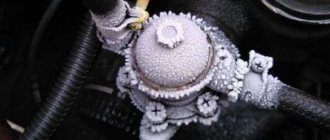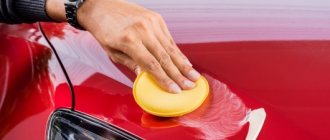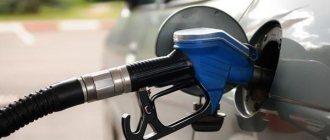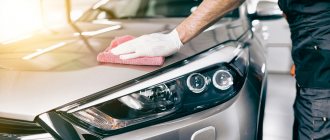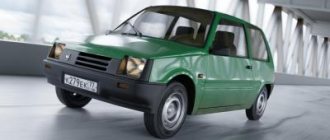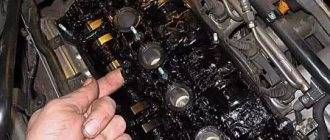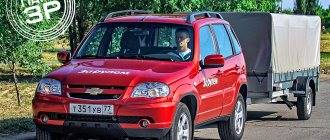Many amateur car painters, when faced with restoring the paintwork of their car for the first time, often ask the question: “How much paint does it take to paint a car, both for one part and for the entire body as a whole?” Let's try to answer this question.
- 1 Material consumption for the machine as a whole and for individual elements
- 2 How long does paint from an aerosol can last?
Material consumption for the machine as a whole and for individual elements
It should be noted right away that there is no clear answer to this question. Many factors play a role here:
- manufacturer of coatings,
- hiding power of paint,
- selected color,
- the size of the element or the car itself,
- color of the substrate or primer,
- transfer coefficient of the spray gun, etc.
Therefore, we will operate with approximate figures. For an average part: wing, door, etc., the enamel consumption is 150 ml, for a bumper you will spend, depending on its size, about 250-300 ml, for the hood you will spend about 400-600 ml of dye.
From this we can conclude that at 1 m? Approximately 200-250 ml of paint and varnish are spent. The varnish consumption is exactly the same (if you do not take into account the hardener and thinner). But provided that you apply it in 2 layers.
The material consumption depends, of course, on what car painting technology you chose, on the thickness of the layers and their number. In general, a medium-sized car (sedan) requires about 2 liters of base and the same amount of varnish. All figures are for materials undiluted. In other words, the hardener and solvent are not taken into account here.
Now to the question of how much paint is needed to paint a car, based on its type. You will need about 2 liters of acrylic composition. An average car will need about 3 liters of alkyd enamel. It should be said that this is only consumption on the outside of the body. If you are going to paint it inside, then the cost of paintwork materials will increase to 4 liters.
What affects consumption?
Paint consumption depends on many components, the most obvious of which are the area of the surface to be painted and the type of paint coating planned to be used. To more accurately calculate the quantity, you will have to take into account many additional factors:
- the condition of the car, its color (if the car is painted over an old coating) or the color of the primer;
- selected dyeing technology;
- thickness of the coating layer;
- number of applied layers;
- brand, type, composition and color of the paint that will be used to paint the surface, its hiding power;
- features of setting up and operating the spray gun;
- paint density, compliance with proportions when mixing components, viscosity of the composition.
The composition of the paint coating and its technical characteristics differ from one manufacturer to another. It is recommended to use enamels, varnishes, primers, and solvents of the same brand for work. In this case, there will be no conflict of compositions, therefore, there will be no additional costs for reworking defects.
The consumption of paints and varnishes largely depends on the viscosity of the working mixture. Painting with a composition that is too thick will turn the surface into an orange peel, which car enthusiasts call shagreen, and a solution that is too thin will spread across the surface in smudges. To achieve the required viscosity, use a viscometer and follow the exact recommendations of the manufacturers. Moreover, all details are taken into account - from the sequence of mixing components to compliance with the temperature regime.
An equally important factor is the correct setting of the spray gun (paint gun), adjusting the pressure, air supply, its sufficient supply for uninterrupted operation and debugging the spraying method. Experience in using a paint gun reduces errors and waste of paint and varnish materials.
Setting up a spray gun for is one of the factors for the correct and effective consumption of lacquer materials
Proper preparation of the base will help reduce paint consumption - thorough priming of the surface of the part or the entire machine (preferably with a composition from one manufacturer) and fine-grained sanding to remove the smallest dust particles.
The hiding power of the enamel – the ability of paintwork materials to paint over previous layers – directly affects the consumption of material.
Advice. If the purpose of painting is to paint over the previous layers with the least amount of material, then it should be taken into account that green and white colors have the greatest coverage, and yellow, red, and blue have the least coverage.
How long does spray paint last?
The question of what area of the car is enough for a 150-gram can of paintwork also does not have a clear answer. For example, manufacturers indicate a very wide range of this parameter: from 0.25 m? up to 0.5 m?. But manufacturers of paints and varnishes cannot give an exact answer, since the amount of consumption largely depends on you.
The cost of the composition will be significantly lower, for example, if the base is finely porous and well polished. This will also be facilitated by the fact that the color of the repaired area of the body matches the paint being applied as closely as possible. The consumption of varnish and paint may also depend on their temperature; too cold paint and varnish forms flowing “tears”.
Material costs are also optimal when old, well-sanded varnish is treated with paint of the same color.
The minimum consumption will be if a light coloring composition is applied to a gray-black base or dark paint to a white base, in this case their covering power will be justified.
But the situation with a light yellow dye on a dark primer is much more complicated, because here the covering ability of the corresponding pigment also plays a crucial role. Among other things, under the same conditions of body surface treatment, aerosol cans, even from the same manufacturer, may not have the same covering power.
How much paint do you need to paint a VAZ 2106
It is impossible to say exactly how much paint will be spent on painting a car, but there are basic principles that will help you understand the cost of paint when painting the body of a car.
The amount of paint is affected by:
- Machine size
- Paint color and original body color
- Paint quality
- Spray type
- Artist Experience
Let's take a closer look at each item.
Of course, the larger the car, the more paint will need to be applied.
For example, painting a small subcompact requires less than 2 liters of undiluted paint, while painting a larger SUV will require more paint. You also need to consider whether the holes will be painted. This will also increase paint consumption.
The amount of paint needed to paint a car also depends on what color the car will be painted and what the initial color of the painted surface will be. If the body panel has a contrasting color with the coating, then more paint will be left accordingly. Colors such as yellow, red and blue are a bit opaque, so more paint may be needed to cover the original color. If the paint does not cover much, you will need to apply a large number of coats to apply the undercoat. For example, red and yellow colors may require up to 10 or more layers.
Colors such as black, white, and bright green have good hidden ability.
If the car is being repainted due to numerous small defects and scratches that are sanded down when preparing the body for painting, then the paint will not go as well as when changing the color of the car.
READ How much paint do you need to paint a bumper?
Complete car painting for 3.5 thousand. from the pelvis to the vases there are 4 parts. Restoration Lada.
The color of the substrate will affect the final shade of the paint.
Notes: Hidden power. This is the ability of a paint to completely cover the color of a surface when sprayed, in other words, to cover the color of the substrate with the color being sprayed. Thus, the more opaque the paint, the less paint will be needed to paint the part.
Paints from different manufacturers may have different compositions and, accordingly, different covering abilities.
High-quality opaque paint can cover the substrate in 2-3 layers.
The paint spray device has a significant impact on paint consumption. HVLP sprayers have a high percentage of transfer of paint material to the surface being painted. For high quality HVLP sprayers this percentage is over 75%. Painted with such aerosols, the paint reaches maximum parts and does not fly around.
From personal experience I can say that when I take high-quality paint in the amount recommended for painting the parts I need, the paint often remains (sometimes more than half). I paint using an Iwata W-101 sprayer purchased from an official representative. Based on my own experience, I am convinced that a high-quality, economical gun significantly reduces paint consumption.
The amount of paint required to paint the car body also depends on the professionalism of the car dealer. An experienced artist will position the spray gun correctly and draw correctly. The paint should not be applied as dust, and when it hits the surface, it should be well distributed. It would be wiser to cover first repair areas and replaced body panels that are a different color from the rest of the body. Next, you can begin to gradually color all parts of the body.
READ How to Replace the Battery in a Toyota Highlander Key
If the car is painted with a paint that needs additional clearcoat, it may require more clearcoat than the base paint. The varnish must be of a certain thickness because it is a protective coating. For example, if the body paint requires about 2 liters of base paint, the varnish may require 3 to 3.5 liters. Even if there is less varnish, it is better to take it with a reserve and not dilute it all at once, but as an expense. The remaining undiluted varnish will be useful later when painting any car.
As a rule, the amount of varnish depends on the area of varnish, and not on the amount of base paint. The amount of paint and varnish can be the same.
From 100 to 300 grams of undiluted paint is used on the body panel. The bumpers, hood and roof of the car are larger than the rest of the body, and painting takes twice as long.
Please note that some parts need to be painted on both sides (top or lid).
If you use paint sparingly, you may need 2 kg of paint for the entire car. Varnishes are needed in approximately the same quantity.
READ Where is the Speed Sensor Lancer 9
Basically, 2-2.5 kg of undiluted paint is enough to paint a four-door car. Since the base paint is diluted from 1 to 1 (1 liter of April (mixed with 1 liter of thinner), then the diluted paint will receive twice as much.
If you need to paint a car with all the openings, you will need 0.5 per paint. 1 kg. Since the base paint is usually thinned 1 to 1, the amount of paint sprayed for spraying will be 2 times as much.
- You should always buy more paint and varnish than you may need. The remainder can be stored until the next repair. Leftover virgin ink can be stored by tightly sealing the container. It does not contain a hardener and will be stored for a long time. Even if the paint thickens after a while, it can always be thinned with thinner. Before applying varnish, dilute half of the varnish you purchased and, if necessary, dilute additional varnish.
- It should be remembered that base paint and two-component acrylic are diluted with different thinners. If the base paint (which requires further varnishing) is diluted with universal acrylic thinner, defects may occur during painting, especially when painting metallic and pearlescent.
Share the post “How much paint does it take to paint a car?”
Source
Machine size
Of course, the larger the car, the more paint you will need to paint it.
p, blockquote 4,0,0,0,0 —>
p, blockquote 5,0,0,0,0 —>
For example, to paint a small subcompact car you will need less than 2 liters of undiluted paint, while painting an SUV with a large body area will require more paint. It is also necessary to consider whether the openings will be painted. This will also increase paint consumption.
p, blockquote 6,0,1,0,0 —>
Paint color and original body color
p, blockquote 7,0,0,0,0 —>
The amount of paint required to paint a car depends on what color the car will be painted and what the original color of the surface to be painted is. If the body panel has a color contrasting to the one being sprayed, then more paint will be needed. Colors such as yellow, red, and blue are low opaque, so more paint may be needed to cover the original color. If the paint has low coverage, then it is necessary to apply more layers to paint the substrate. For example, when painting with red and yellow paint, up to 10 or more layers may be required.
p, blockquote 8,0,0,0,0 —>
Colors such as black, white, and bright green have good hiding power.
p, blockquote 9,0,0,0,0 —>
If a car is repainted due to numerous minor defects and scratches that are sanded off during preparation of the body for painting, then less paint will be used than when changing the color of the car.
p, blockquote 10,0,0,0,0 —>
The color of the substrate will affect the final shade of the paint.
p, blockquote 11,0,0,0,0 —>
Note: Hiding power is the ability of paint, when sprayed, to completely cover the color of the surface, that is, to cover the color of the substrate with the sprayed color. Thus, the more opaque the paint, the less it will be needed to paint the part.
p, blockquote 12,0,0,0,0 —>
Painter experience
The amount of paint required to paint a car body also depends on the professionalism of the car painter. An experienced painter will set up the paint gun correctly and distribute the paint correctly. The paint should not be applied in the form of dust, but should spread well when it hits the surface. It is wiser to first paint over repair areas and replacement body panels that are a different color than the rest of the body. Then you can proceed to the step-by-step painting of all body parts.
p, blockquote 18,0,0,0,0 —>
Base paint + varnish
If the car will be painted with paint that requires further varnish, then more varnish may be required than base paint. It is necessary to create a certain thickness with varnish, since it is a protective coating. For example, if it takes about 2 liters of base paint to paint the body, then 3 – 3.5 liters of varnish may be required. Even if a smaller amount of varnish is used, it is better to take it in reserve and dilute it not all at once, but as it is used. The remaining, undiluted varnish will be useful in the future when painting any car.
p, blockquote 19,0,0,0,0 —>
In general, the amount of varnish depends on the area to be varnished, and not on the amount of base paint. The amount of paint and varnish may be the same.
p, blockquote 20,0,0,1,0 —>
The amount of paint required to paint the entire car
If you use paint economically, you may need 2 kg of paint for the entire car. You need about the same amount of varnish.
p, blockquote 23,0,0,0,0 —>
p, blockquote 24,0,0,0,0 —>
Basically, 2–2.5 kg of undiluted paint is enough to paint a four-door sedan. Since the base paint is diluted 1 to 1 (1 liter of paint is mixed with 1 liter of thinner), you will get twice as much diluted paint.
p, blockquote 25,0,0,0,0 —>
If the car needs to be painted along with all the openings, then you will need 0.5 - 1 kg more paint. Since the base paint is usually diluted 1 to 1, the amount of paint diluted for spraying will be 2 times greater.
How much paint does it take to paint a car? Tuning vehicles costs money, and all owners want their car to meet all the requirements. You can paint the body yourself if you have experience working with materials, the skills to calculate a sufficient volume, and select the appropriate substance.
For finishing in the garage, a base is used that is varnished. Acrylic enamels have a good shine due to their composition, so they can be varnished as desired. It is more difficult to work with red, yellow, and blue colors - you have to apply several layers to paint over the original shade.
Which car paint is better to choose?
For painting your car yourself, there are the following types of paints:
- acrylic;
- alkyd;
- nitro enamels;
- cellulose;
- metallics;
- Griftal.
Each tool has its own advantages and disadvantages.
Acrylic enamel is most in demand; it is suitable for complete repainting of the car. Its features:
- easy to use;
- lays down evenly;
- dries quickly;
- the resulting surface is resistant to solvents, reflects light well, and therefore does not require varnishing;
- due to insufficient covering power it is necessary to apply 2-3 layers.
The surface covered with hard-setting acrylic enamel is durable, while the soft-setting type is highly polished.
Alkyd enamel is suitable when you need to paint a small area. Its features:
- low cost (cheaper than acrylic);
- easy application;
- good covering power, it is enough to apply 1-2 layers;
- dries slowly (this process can be influenced by adding an accelerator to the enamel or increasing the drying temperature);
- The surface is difficult to polish and needs to be varnished.
How to make the correct calculations for varnish and paint
The above factors and manufacturer's advice affect the consumption of mixtures during operation. Solvent is added to the undiluted base before carrying out work.
- The volume of solvent is 20% of the base, but each type of enamel has its own proportions.
- Average figures for finishing are 200-250 ml of enamel and the same amount of varnish.
- A passenger car requires approximately 3 liters, and a gazelle – up to 5 liters.
- When painting elements on 2 sides, you will need 2 times more mixture.
- Acrylic is consumed 60% less than alkyd.
What to consider when calculating
If you go to the store to buy paint, you will realize that it is quite expensive. Therefore, there is no point in overpaying by buying extra goods; it is enough to make the correct calculation. At the same time, if during work it turns out that there is not enough paint, you will have to buy it additionally. But then it can be quite difficult to choose the right shade, because even in different batches they can differ.
To understand how much dye you need, you need to consider the following factors:
- car model and its condition;
- type and packaging of paint;
- the presence or absence of tools necessary for painting;
- time of year, weather conditions, location of work.
Calculating the amount of paint for painting a car
Having examined the most important points in detail, it will be much easier to understand the issue of painting.
Painting rules
- The temperature of the air in the garage and the parts should be the same.
- Surfaces must not be heated before finishing.
- Sticky wipes help to apply the material evenly and remove dust and debris from the element before processing.
- The body is always protected with goggles, a respirator, and a special overall.
- Old body parts are used for training.
Components of quality formulations:
- Primary color pigment.
- Binder.
- Solvent.
The following substances are used for finishing in the garage:
Advantages of acrylic compositions:
- Affordable price and good quality.
- Applies evenly to the surface.
- Naturally sparkles.
- It lasts a long time.
- Little consumption - 200 ml per 1 sq. m.
- Does not require special skills to operate.
- Applies in a few hours.
Acrylic withstands minor impacts well, scratches do not appear.
- Highly flammable.
- Fades quickly in the sun.
- A thin layer is applied several times.
Many acrylic enamels consist of 2 components, and in order for the mixture to dry on the body, a hardener is added, and varnish is applied in rare cases.
Glypthal dry slowly, are better absorbed at high temperatures, and polymerize in 2 to 4 weeks.
Alkyd enamels are difficult to polish and it is difficult to achieve shine. They take longer to dry, require heating, and collect dust. Suitable for use in professional workshops.
Most car enthusiasts prefer two-layer mixtures with base and varnish. Green or gray color is easier to apply and covers the original layer faster. Most often, enamel is applied 2-3 times, so it is necessary to accurately calculate the amount.
We recommend watching:
How many cans of paint do you need to paint a car?
Can paint be thinned with gasoline?- How to dilute acrylic varnish for cars
- Vetch alkyd air drying paint, how to dilute it
- How long does it take to apply varnish after painting a car?
- Which spray paint is better?
How and how a car is spray painted
Spray painting a car is a simple process. On the parts of the body of each car scratches, chips, and small spots appear from the impact of crushed stone. Sometimes defects can be eliminated yourself; aerosols and solvents are used for this. Painting a car with a simple spray can is done according to the instructions. First, the scratched body element is removed for convenience. Spray painting your car is done in a regular garage; for this, the entire room is treated with water, dust is removed, and dirt is prevented from getting on the paint.

